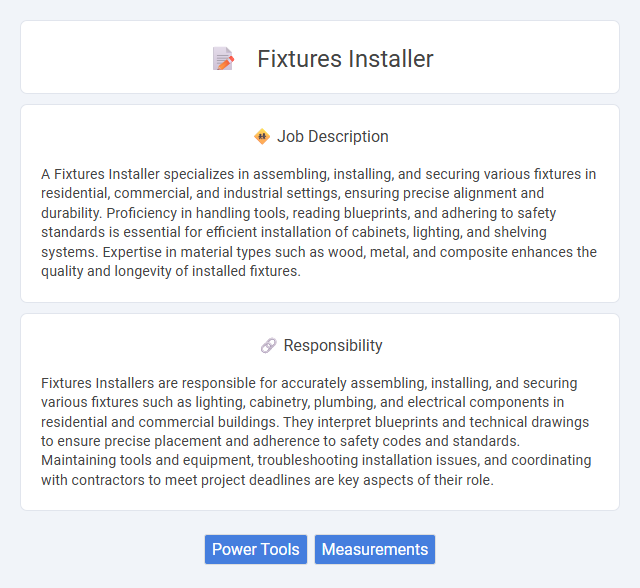
A Fixtures Installer specializes in assembling, installing, and securing various fixtures in residential, commercial, and industrial settings, ensuring precise alignment and durability. Proficiency in handling tools, reading blueprints, and adhering to safety standards is essential for efficient installation of cabinets, lighting, and shelving systems. Expertise in material types such as wood, metal, and composite enhances the quality and longevity of installed fixtures.
Individuals with strong physical stamina and good hand-eye coordination are likely suitable for a Fixtures Installer role, as the job often requires lifting, precise placement, and repetitive tasks. Candidates who can tolerate variable work environments and maintain focus during physically demanding activities probably perform well in this position. Those with limited mobility or difficulty working in dynamic settings may find the role less compatible with their abilities.
Qualification
A Fixtures Installer must have a high school diploma or equivalent, with hands-on experience in carpentry, electrical, or plumbing work preferred. Proficiency in reading blueprints, technical drawings, and using hand and power tools is essential. Strong attention to detail, physical stamina, and knowledge of safety standards enhance job performance and qualification.
Responsibility
Fixtures Installers are responsible for accurately assembling, installing, and securing various fixtures such as lighting, cabinetry, plumbing, and electrical components in residential and commercial buildings. They interpret blueprints and technical drawings to ensure precise placement and adherence to safety codes and standards. Maintaining tools and equipment, troubleshooting installation issues, and coordinating with contractors to meet project deadlines are key aspects of their role.
Benefit
A Fixtures Installer job likely offers consistent employment opportunities given ongoing demand in construction and renovation projects. Benefits may include hands-on skill development, potential for overtime pay, and expanding expertise with various installation techniques. Workers probably gain satisfaction from seeing tangible results and contributing to functional, aesthetically pleasing spaces.
Challenge
A Fixtures Installer likely faces challenges related to precision and time management when aligning and securing various fixtures in diverse environments. The probability of encountering unexpected obstacles, such as structural inconsistencies or unconventional layouts, requires adaptability and problem-solving skills. Ensuring safety and compliance with industry standards adds an additional layer of complexity to the role.
Career Advancement
A Fixtures Installer plays a crucial role in construction and renovation projects by accurately assembling and securing cabinetry, lighting, and plumbing fixtures. Mastery of technical skills and attention to detail enables progression to supervisory roles or project management positions within the building trades. Expanding expertise in advanced installation techniques and industry standards significantly enhances career advancement opportunities.
Key Terms
Power Tools
Fixtures installers rely heavily on power tools such as drills, impact drivers, and oscillating multi-tools to efficiently secure lighting, shelving, and cabinetry. Mastery of these advanced tools enhances precision and speed when mounting fixtures on various surfaces like drywall, wood, and metal. Proper maintenance and safety protocols for power tools are essential to ensure consistent performance and reduce workplace accidents.
Measurements
Precision in measurements is crucial for Fixtures Installers to ensure accurate placement and alignment of fixtures according to design specifications. Mastery in reading blueprints and using measuring tools like laser levels and tape measures guarantees the correct installation of lighting, plumbing, and cabinetry fixtures. Accurate measurements prevent costly errors and enhance the overall structural integrity and aesthetic appeal of the installation.
 kuljobs.com
kuljobs.com